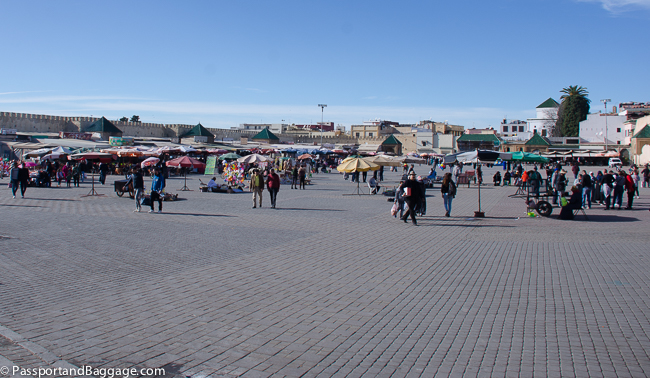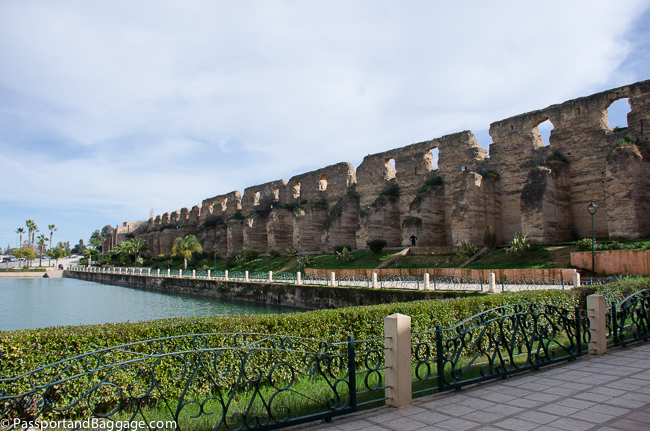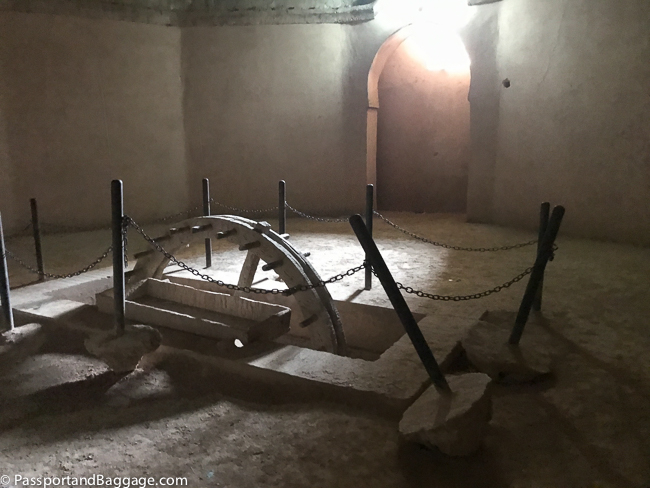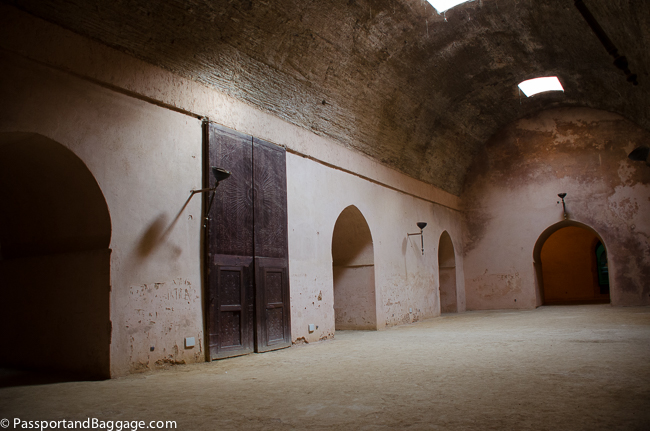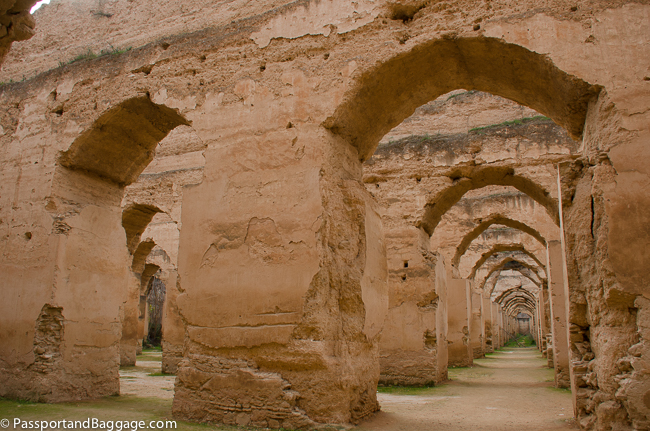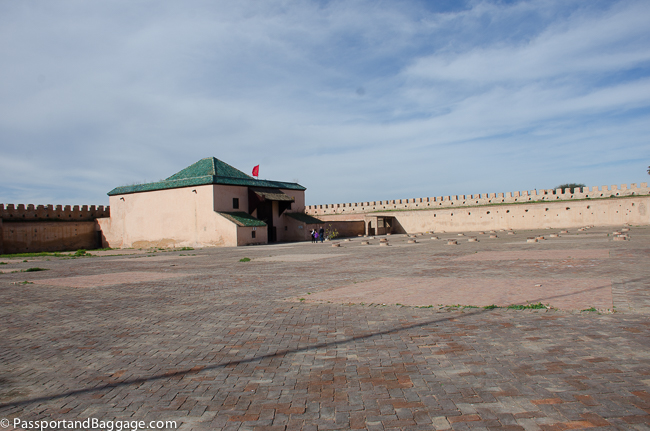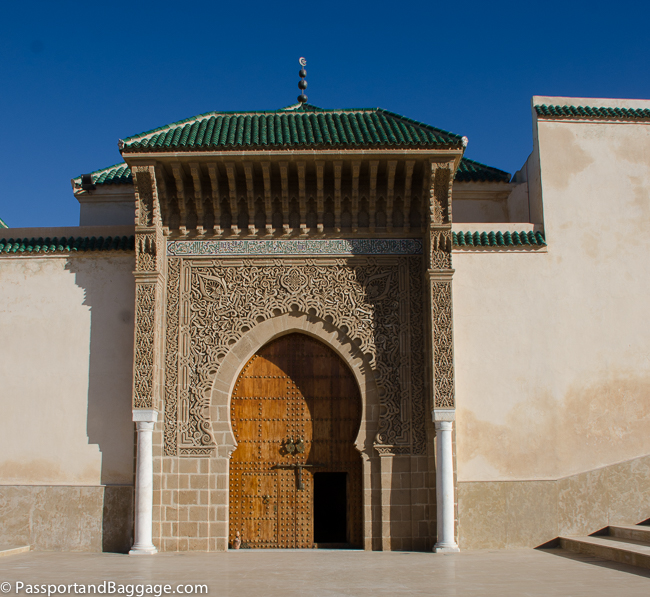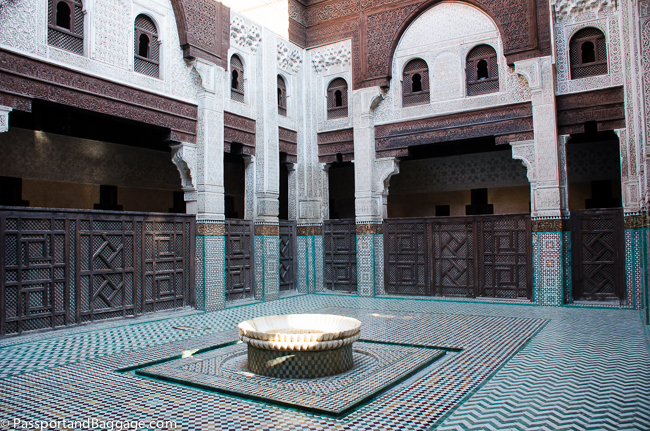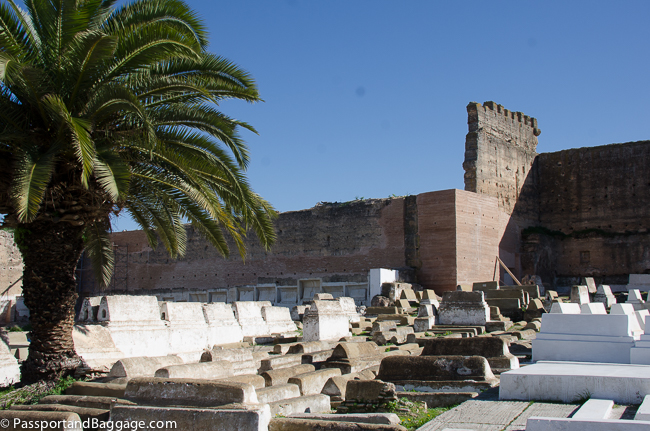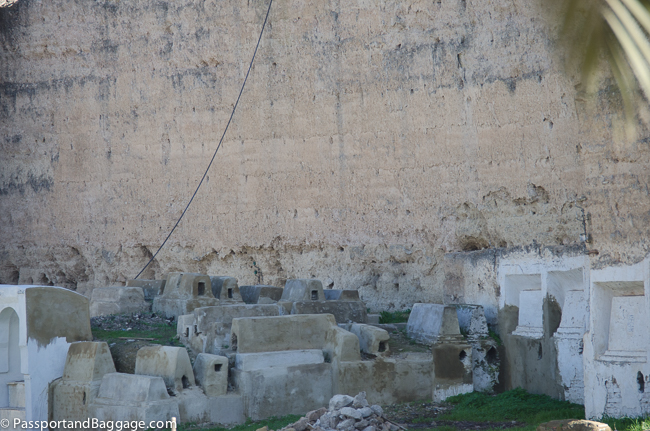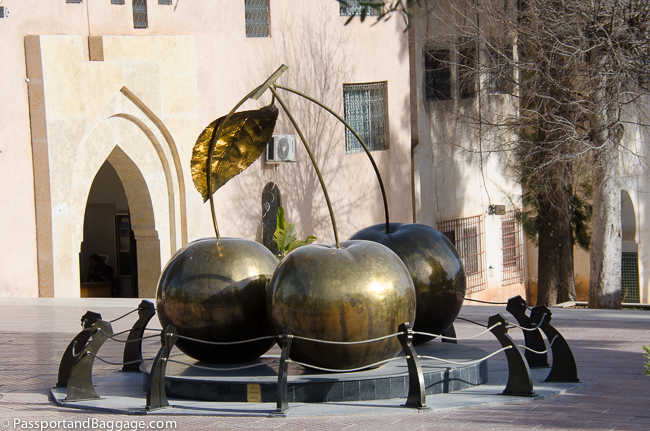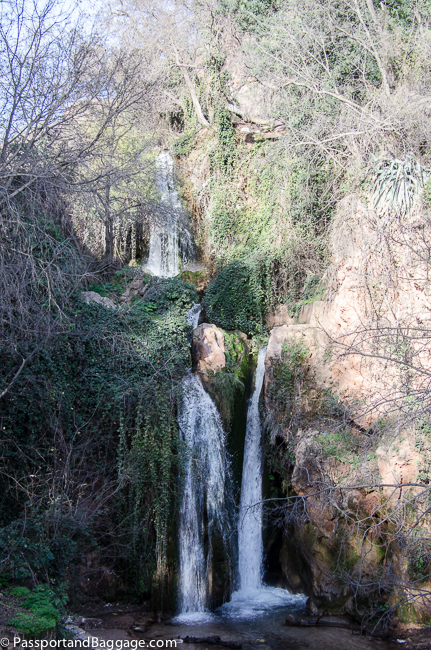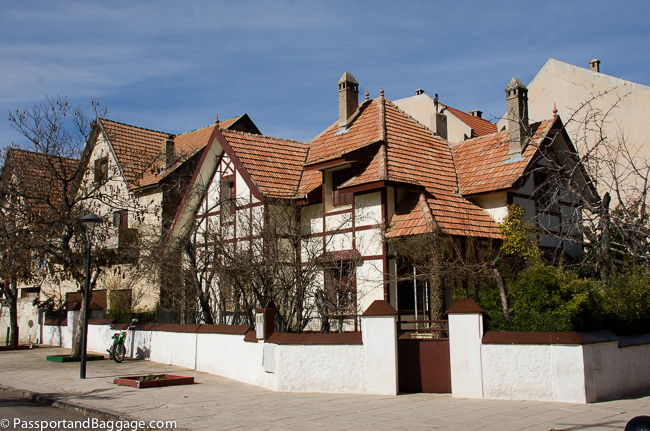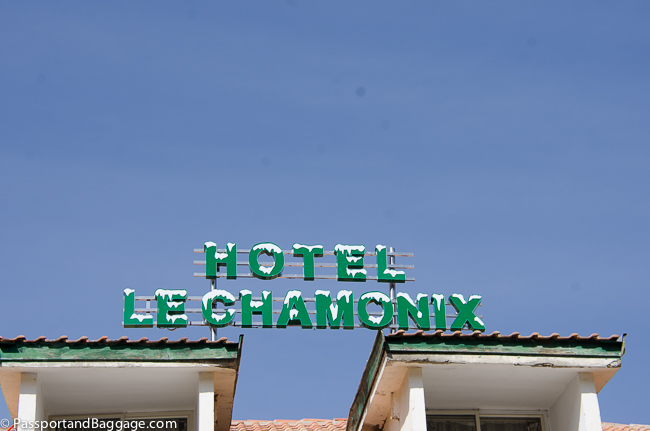December 26, 2019
Meknes was first settled in the 9th century by the Miknasa a southern Tunisian Berber tribe.
In the 11th century, the Almoravids further developed Meknes as a military settlement. They built mosques, hammams and kasbahs, one royal palace and a madrassa.
The city was captured by several dynasties but eventually became a capital city under Sultan Moulay Ismaïl (1672–1727), the founder of the Alouite dynasty.
Moulay Ismail managed to build a city wall nearly 30 miles long with twenty gates surrounding more than 50 palaces.
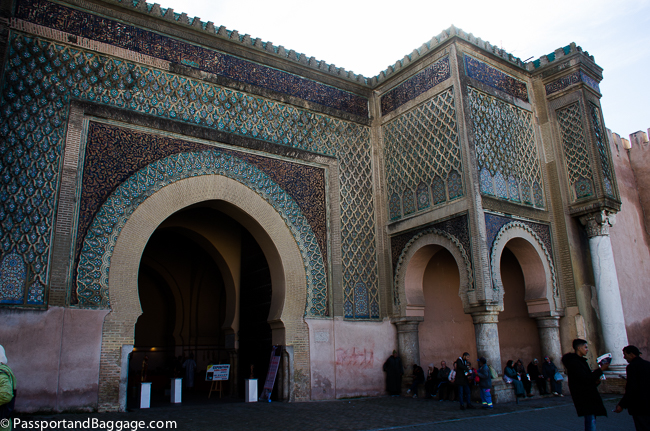
Bab Mansour was the last important construction project ordered by Sultan Moulay Ismail. It was to be an elaborate homage to himself. The architect who designed the gate was a Christian convert to Islam named Mansour Laalej (whose name translates to “victorious renegade”) who sought to work his way into the sultan’s court. His name also contributed to the name of the gate (Mansour means “victorious” in Arabic).
Behind these high defensive walls are twenty-five mosques, ten hammams, a few remaining palaces, a huge granary, remains of fondouks (caravanserai) and private homes, all from the Almoravid, Merinid and Alawite Periods.
It was Moulay Ismail’s goal to make this the most beautiful of all the Imperial cities. Something only a man, who was a great admirer of Louis XIV and was often called the Moroccan Louis the 14th could inspire to.
The two gentlemen were allies and in 1682, Ismail sent Mohammed Tenim, to be his ambassador in France. French Baroque painter Charles Antoine Coypel depicted the Moroccan ambassador’s visit in his painting titled Mohammed Tenim, Ambassadeur du Maroc à la Comédie Italienne.
Sultan Moulay Ismail was a man of excesses. A ruthless tyrant, he had a harem of 500 wives and concubines and fathered hundreds of children. (The Guinness Book of Records has that number at 800).
It is said he beheaded over 36,000 people, a number historians find a tad too large, but they do agree the number could be as high as 20,000. It is said some of his justification for this was his view that: “My subjects are like rats in a basket, and if I do not keep shaking the basket, they will gnaw their way through.” From all I could read he was an equal opportunity beheader, your religion or color was of no consequence.
After Ismail’s death in 1727, when his son moved the capital to Marrakesh, the city started its decline. The 1755 earthquake that devastated Lisbon also brought down a lot of Meknes.
In 1912 the French turned Meknes into their military headquarters. Today it is primarily a town supported by agriculture, in particular, the olive trade, and industries that spew black smoke into the environment from their smokestacks.
The story is told about El Hedim Square that the Sultan demolished homes to make way for a grand entrance to one of his new palaces. It apparently got its name, The Square of Demolition, because it stored materials he pillaged from around Morocco, especially from Volubilis. Some say it also served as an execution arena.
Mulay Ismail had this artificial lake, Sahrij Swani, constructed to guarantee the supply of water, in times of siege or drought, to the palaces and mosques of the town, as well as to the public baths, homes, gardens and the orchards that surrounded the town that provided the city with food. The water came from the River Bufekrane, which comes down from the Middle Atlas mountains crosses the southern part of Meknes and feeds the lake and parts of the town.
Because of the strategic nature of this water source, a defensive wall was built surrounding the lake, of which only a portion remains today.
The Sahrij Swani, also called the Basin of the Norias, is only one part of a major compound that includes grain silos and/or a stable and a house referred to as “The House of the Ten Norias”.
The House of Ten Nories is a series of ten small rooms surrounding a central chamber. Originally each room contained a noria, or deep well, that reached the underground water source by means of a chain of buckets. This water was then pumped into the lake via underground pottery pipes.
According to Meknes de Bab en Bab by Hammad Berrada, the rooms off of the water wheels were silos specifically built for food storage and in particular wheat.
The walls of this structure are especially thick to maintain a constant temperature for proper storage. Mules from all over the country brought grain to these silos, which was often taxes paid by tribes outside of the city. These silos also held the fodder for the 12,000 horses in the Sultan’s stud farm. Adjacent to this building is a building that has 22 arcades each consisting of 14 arches, and that, according to Meknes de Bab en Bab is where the Sultan’s horses were kept in high style.
At this point, there are conflicting articles. According to Andalusian Morocco: A Discovery in Living Art, sponsored by the Moroccan Government, the stables were the silos and their explanation of the House of Nori’s is scant at best.
A native of Morocco I spoke with said, that Meknes de Bab en Bab is the accurate one.
At least the grain story seems to holds true, according to the 19th-century historian al-Nassiri: “Mulay Isma’il also ordered for the construction of a granary to be built inside the Kasbah which would be used for provisions, with vaulted corridors for the storage of wheat and other grains, which could hold enough grain to feed every inhabitant of Morocco”
The Koubba el Kayatine is a very small tiled room where Ismail received foreign ambassadors. A stairway just to the right the Koubba el Khayatine pavilion leads to the Habs Qara, vaults which are said to have served as a prison for the European slaves who worked on the construction of the imperial city. It is claimed that the underground chambers ran for over 4 miles and that up to 40,000 slaves were incarcerated here each night in total darkness (the tiny windows in the roof were made by the French). It is just as likely that it was grain storage. Again, the history of Meknes is a bit fuzzy when it comes to reliable sources.

Habs Qara consists of long hallways of arches all intersecting at various places. There are not really any rooms.
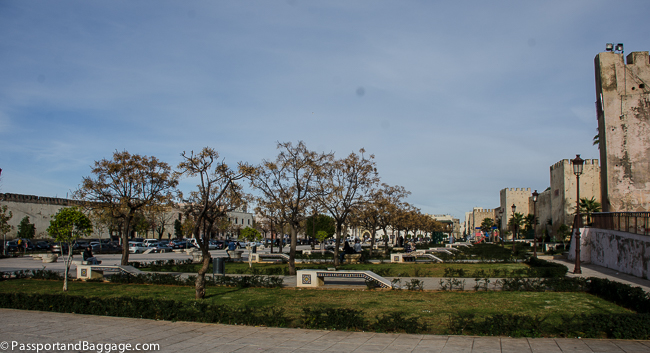
Place Lalla Aouda was once the parade ground where Moulay Ismail inspected his famed Black Guard, which started with some 16,000 enslaved men from sub-Saharan Africa.
In 1699, Ismail gave orders to enslave all black Africans in Morocco, even those who were born free or who were Muslim, and, consequently, he violated two of the central tenants of Islamic law. Moroccan registers show that Ismail enslaved over 221,000 black Moroccans between 1699-1705.
The Black Guard were primarily descendants of black captives brought to Morocco from sub-Saharan Africa, as slaves. At age 10 both boys and girls were trained in certain skills, and at age 15 those boys that were chosen entered the army. They would marry and have children and continue the cycle. Ismail’s black soldiers formed most of his standing army and numbered 150,000 at their peak.
Ismail was always surrounded by a bodyguard of eighty black soldiers, armed with muskets and scimitars. At his throne, he was attended by a servant charged with twirling a parasol above his head at all times (a legend says that on at least one occasion, Ismail pulled out his sword and murdered an attendant who had allowed the sun to briefly fall upon him).
After Ismail’s death, the quality of the Black Guard went downhill, as they were no longer paid as well. The main group was dissolved in the 19th century.
Built before he died to ensure its grandeur, the Mausoleum of Moulay Ismail has been closed for renovation since 2016. It has a scheduled re-opening sometime in 2020. Non-muslims were admitted prior to the closing, it is not known if that will be the case after the renovation. Sadly what is considered the best museum in all of Morocco, the Dar Jamal Museum, is also closed for renovation. That is the way of travel.
For 60 MDH you can see the Bou Inania Madrassa. It is so similar in design to so many that one encounters in Morocco with its interior courtyard, classrooms of to one side and small living cubicles on the second floor. What is always so beautiful in these buildings is the craftsmanship of the interior courtyards. Built in 1341, the madrasa is considered one of the best monuments the Marinids have left.
Before the founding of Israel in 1948, Morocco had the largest Jewish community in the Muslim world, with more than 200,000 citizens, fewer than 2,500 still live in Morocco today. A wave of attacks and economic boycotts of Jewish businesses helped drive thousands of Morrocco’s Jews to emigrate mostly to Israel.
A rehabilitation program, dubbed “Houses of Life,” began in 2010 under the purview of the Moroccan government to restore the Jewish cemeteries spread throughout Morocco. Many of the Jewish cemeteries were in severe decay with eroded gravestones, treacherous pathways, and unclear boundaries.
Thus far in the restoration, crews have demolished 32,480 feet of old walls, built 137,795 feet of new walls, installed 159 new doors, laid 534,966 square feet of pavement, rehabilitated damaged mausoleums, and cleaned and restored many graves.
They are still working on this in Meknes.
Small Cities outside of Meknes
Just 50 or so miles from Meknes is the town of Sefrou, known for its Sefrou Cherry Festival, a UNESCO-endorsed event held every June. Originally launched in 1920, and lasting three days, the festival consists of a beauty contest for the title of Miss Cherry, folk music, traditional cuisine, performances, and sporting events.
The modern town of Ifrane was established by and for the French administration in 1928 due to its Alpine climate. It was conceived as a “hill station” or colonial type of settlement. It is now a resort town high up in the mountains where people can find relief from the summer heat. Ifrane is also a popular altitude training destination. The place mimics a Swiss ski village.
As you enter the main square you can not help but see the number one photo attraction of the town, the stone lion.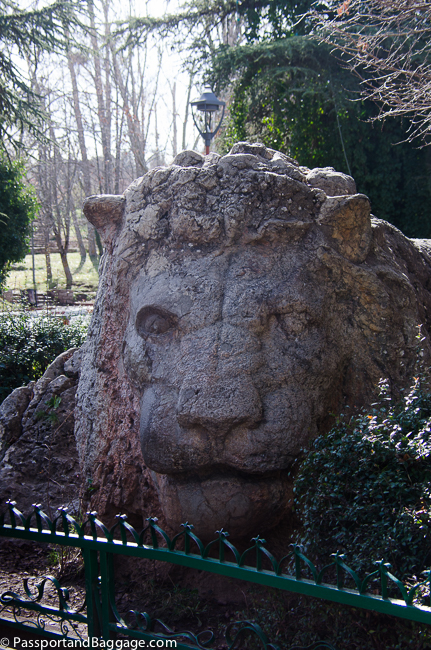 The popular story of the origin of Ifrane’s lion involves an Italian prisoner of war sculpting it out of an outcrop of limestone, however, this is not true as the lion dates from at least 1936 thus predating World War II. The mystery continues.
The popular story of the origin of Ifrane’s lion involves an Italian prisoner of war sculpting it out of an outcrop of limestone, however, this is not true as the lion dates from at least 1936 thus predating World War II. The mystery continues.
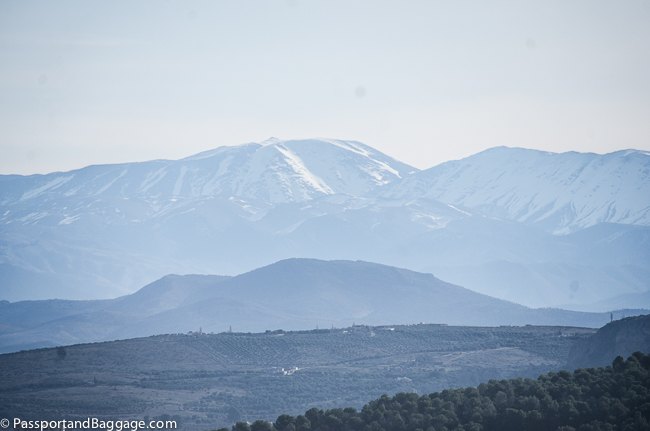
Because of its elevation, Ifrane experiences snow during the winter months and a cool climate during the summer
I spent three full days in Meknes, and truth be told, that is two too many. Meknes makes a nice day trip from Fez, as would the three other cities I explored from here. The Medina is sprawling, but like so many other Medinas spread across Morocco and Tunisia, it really has nothing new to offer.
If you do come to Meknes for a night or two know that it is a very crowded and very loud city. There are not many quality places to stay in Meknes, but I found the Riad Lahboul to be delightful. It has a stunning terrace for getting away from it all and a more than kind and helpful staff.
